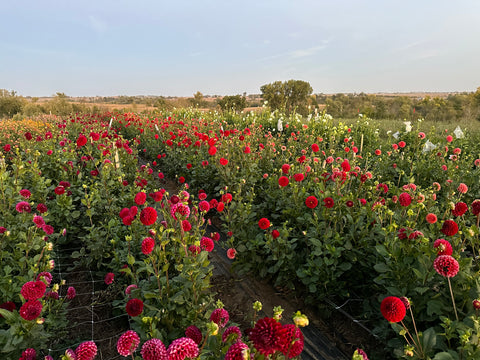Guide to Growing Dahlias

A Guide to Growing Dahlias
Site Selection
For the most blooms on sturdy stems, plant dahlias where they will receive a minimum of 6 hours of direct sunlight.
Dahlias do best in well-draining soil. When they are actively growing they require a lot of water, but too much soil moisture can lead to the tubers rotting in the ground.
Planting Date
Dahlias are very sensitive to cold. Wait to plant tubers until after the average last frost date in your region and once the soil has warmed to 60-70°F. In our zone of 5a in east central Iowa, we usually plant our dahlias towards the middle or end of May. Planting tubers in cold soil can lead to early tuber rot - so don't be hasty!

Planting
When you are ready to plant, loosen the soil to a depth of 6-8 inches. This is a great time to add compost to your planting area. Plant tubers on their side (horizontally) with the eye facing up and then cover with soil. Dahlias can be spaced as close as 12" apart if you are planning on pinching (seeing below) and cutting the flowers regularly. Otherwise, plan to leave at least 2 ft between plants for good airflow in the garden.
Dahlias can also be grown in pots. Plant them in a pot that is at least 12" in diameter so the tubers have adequate room to grow.
Do not water the tuber in at planting! Begin watering only when you see the sprouts emerging from the soil surface, usually in about two weeks from planting. Unless the soil is exceptionally dry, then you can moisten it slightly at the time of planting. Excessive water before the sprouts emerge can contribute to the tubers rotting in the ground. Rain is fine, though if you see a heavy rainstorm in the forecast you might want to wait until its passed and the soil has dried out slightly to plant your tubers.
Make sure to label the tubers you are planting if you want to remember which variety you planted. Since dahlias are only true-to-type from dividing the tubers, it's worth the effort to keep them marked and mapped!
Growing
Once dahlias have sprouted, mulch around the base of the plant with straw or shredded leaves to help conserve moisture & minimize weeding. Dahlias require a lot of water while they are actively growing - at least 1" of water a week. A long, deep watering less frequently is better than frequent shallow waterings.

Pinching & Trellising
Most dahlias will reach 5 feet or taller by the end of the season and will need structural support to stay upright. If you are planting individual tubers around your landscape, you can use a t-post or wooden stake next to each plant and use twine to gently tie the plant to the post. Make sure to leave 8-12" between the dahlia and the post so you don't damage the tubers when pounding in the t-post/stake.
If you've planted your dahlias in rows, you can use the same method of t-posts or wood stakes and use twine to corral them together.
Pinching is a practice utilized by many cut flower growers to increase the overall number of flowers each plant produces. Once your dahlias are between 8-12" tall, cut the central stem back 4-6", just above a leaf node. This will signal the plant to send energy into producing side branches - yielding a sturdier plant and many more blooms overall.
Fertilization
Dahlias are heavy feeders and benefit from fertilization. Top-dress or apply a foliar-spray with a balanced fertilizer once or twice as they are growing. Once the dahlias begin flowering, discontinue fertilizing.


Harvesting
Harvest dahlia flowers when they are almost fully mature. The flowers do not open much more in the vase after they are cut. Using sharp & clean shears or snips, cut the stem at least 12" long and just above a leaf node. The deeper the cut you make, the longer the subsequent stems will be. Strip the foliage from the bottom half of the stem and place immediately into cool water. Dahlias have a typical vase life of 5-7 days.
Ready to grow your own dahlias?
Shop Dahlia Tubers


